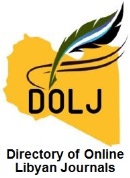دراسة تداخل مياه البحر والمياه الجوفية في منطقة تاجوراء
DOI:
https://doi.org/10.59743/jmset.v1i2.123الكلمات المفتاحية:
التداخل، مياه البحر، الكهروكيميائية، المقاومةالملخص
تم دراسة منطقة تاجوراء بهدف معرفة مدى تداخل مياه البحر مع المياه الجوفية وأستخدم في الدراسة طريقة قياس المقاومة النوعية للطبقات التحت سطحية وتمت القياسات في الحقل باستخدام جهاز قياس المقاومة النوعية وبترتيب شلمبرجير وبواقع نشر أقطاب تيار كهربائي متغيرة مساوية إلى مسافة قصوى 400 متر وأخذت قراءات لثماني عشر 18 جسة كهربائية داخل منطقة الدراسة التي بها مجموعة أبار تمت دراستها سابقا بطريقة التحليل الكيميائي لعينات الابار وقد تم تحليل وتفسير المعطيات الكهربائية ورسم المقاطع العمودية والخرائط الكنتورية لخطوط تساوي المقاومة النوعية وقد تبين بشكل واضح تداخل مياه البحر بمنطقة الدراسة.
التنزيلات
المراجع
Dobrin M. and Savit C.H. (1976). Introduction to geophysical prospecting. 3rd edition, McGraw Hill, USA.
General Authority of water (2005). Tripoli, Libya.
Goboda I. (1998). Study of seawater intrusion in Tripoli area using remote and sensing chemical analyzing well samples. M.Sc. thesis, Faculty of Science, University of Tripoli, Libya
Ranjan P. (2007). Effect of climate change and land use change on saltwater intrusion. Encyclopaedia of Earth. Eds. Cutler J. Cleveland (Washington, DC, Environmental Information Coalition, National Council for Science and Environment).
Telford W.M., Geldart L.P., and Sheriff R.E. (1990). Applied geophysics (Vol. 1). Cambridge university press.
USGS (United States Geological Survey) (2007). Groundwater Depletion Across the Nation. Retrieved on February 14, 2008 [Available on: http://pubs.usgs.gov/fs/fs-103-03/].
التنزيلات
منشور
إصدار
القسم
الرخصة
الحقوق الفكرية (c) 2015 مجلة علوم البحار والتقنيات البيئية

هذا العمل مرخص بموجب Creative Commons Attribution 4.0 International License.












